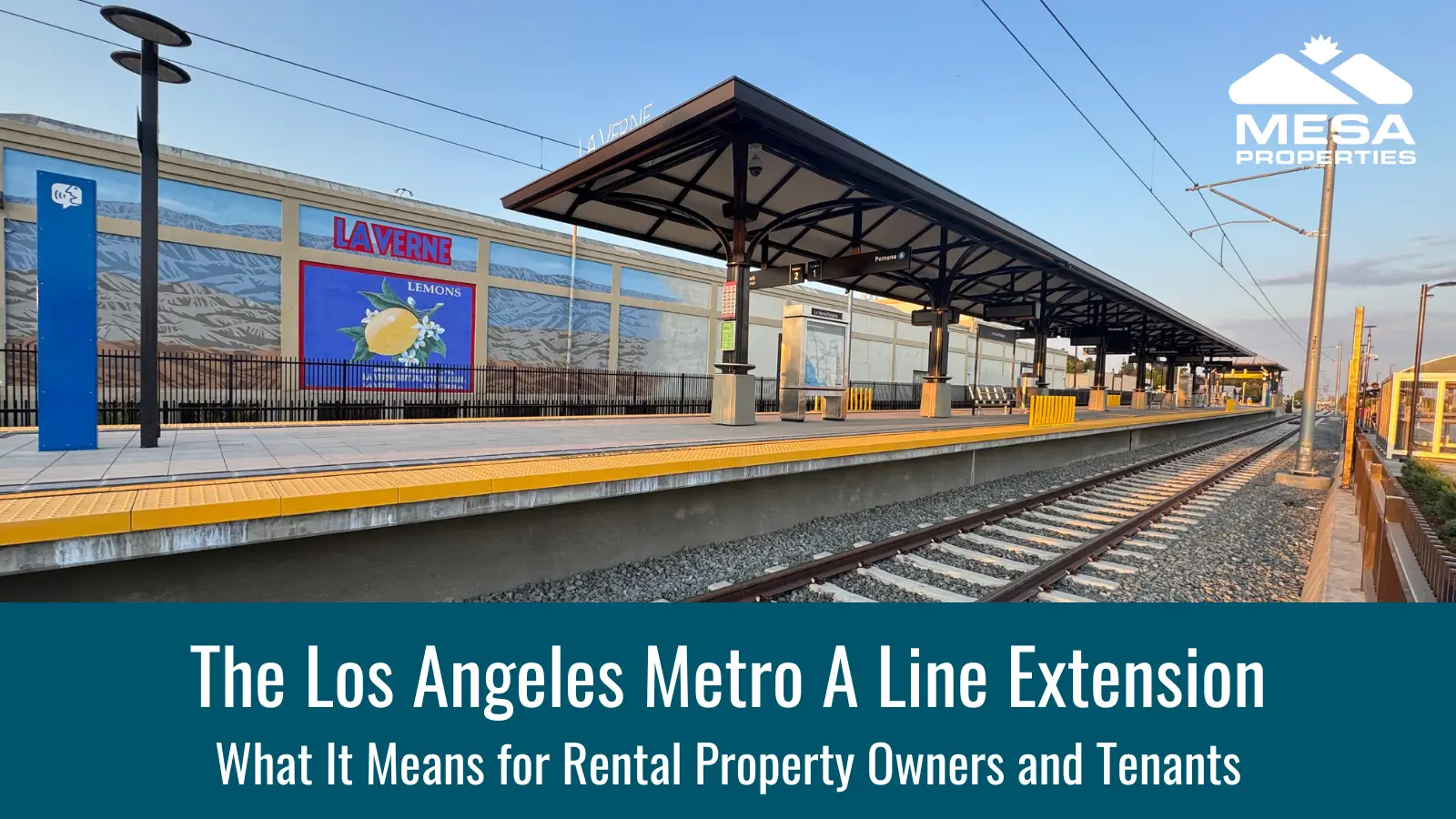On September 19, 2025, the Los Angeles Metro will officially open the highly anticipated extension of the A Line (formerly the Gold Line) from Glendora to Pomona. This milestone doesn’t just mark another infrastructure upgrade for Southern California; it makes the A Line the longest light rail line in the world, spanning nearly 58 miles and connecting dozens of communities from Long Beach to Pomona.
For the Inland Empire and San Gabriel Valley, this extension represents more than just new train stops. It’s a game-changer for rental property owners and tenants, reshaping commuting patterns, boosting property demand, and enhancing the livability of the cities it serves.
At Mesa Properties, we manage rental homes in many of the corridor cities touched by the A Line: Azusa, Glendora, San Dimas, La Verne, Pomona, and future stops in Claremont and Montclair. Here’s what this expansion means for our owners, residents, and communities.
Key Takeaways
The A Line extension opens September 19, 2025, connecting Glendora through Pomona.
It is now the longest light rail line in the world, spanning nearly 58 miles.
For owners, this means rising property values, stronger tenant demand, and long-term community growth.
For tenants, it means shorter commutes, affordability with access to LA, and lifestyle improvements.
Mesa Properties manages rental homes in several corridor cities, positioning our owners to benefit from this transformative investment.
A Closer Look at the A Line Extension
The 9.1-mile extension adds four new stations:
Glendora
San Dimas
La Verne (Fairplex area)
Pomona North, which offers a new transfer connection to Metrolink’s San Bernardino Line
Once open, this stretch links residents to a one-seat ride spanning Long Beach, downtown Los Angeles, Pasadena, and now Pomona. Planned future phases will extend service into Claremont and Montclair by 2030, further tying the Inland Empire into LA’s regional transit network.
Each station is designed for multi-modal access, with bike shelters, EV charging, park-and-ride lots, and drop-off areas, making the line a flexible hub for commuters.
Why This Matters for Rental Property Owners
1. Increased Property Values
Proximity to transit has historically boosted real estate values. With the A Line now accessible in cities like Glendora, San Dimas, and Pomona, rental homes within a short drive or walk to stations are likely to see appreciation in value and demand. Tenants increasingly weigh commute convenience as a deciding factor, and being near a light rail station gives your property an edge.
2. Stronger Rental Demand
Renters today are drawn to communities that offer urban conveniences without urban prices. The A Line makes suburban and Inland Empire cities more attractive by providing seamless access to downtown LA, Pasadena, and job hubs without the burden of long freeway commutes. That means lower vacancy rates and a larger tenant pool for property owners.
3. Transit-Oriented Growth Opportunities
Transit infrastructure often catalyzes development. Over the next decade, expect to see retail, housing, and mixed-use projects pop up near A Line stations. For owners, this translates into long-term growth potential, both in terms of appreciation and the ability to market properties as part of thriving, connected communities.
Why This Matters for Tenants
1. Shorter Commutes and More Options
Tenants working in Pasadena, downtown Los Angeles, or Long Beach can now live in Glendora, Pomona, or San Dimas while enjoying a direct rail ride to their jobs. This means less time in traffic, lower gas costs, and improved work-life balance.
2. Affordable Living with Big-City Access
Living in the Inland Empire is generally more affordable than in Los Angeles County’s urban core. The A Line bridges that affordability gap, allowing tenants to enjoy lower rent in cities like Pomona or La Verne while staying connected to big-city opportunities.
3. Sustainable and Stress-Free Transportation
As tenants increasingly prioritize sustainability and lifestyle, access to a world-class light rail line is a major plus. The ability to bike to a station, plug into an EV charger, or hop on a train instead of sitting on the 10 Freeway makes communities more appealing for today’s renters.
City-by-City Impact
Azusa: Already on the A Line, Azusa renters now have expanded eastbound connectivity, strengthening its role as a gateway city.
Glendora: The new station adds prestige and convenience, making Glendora an even stronger rental market.
San Dimas: Historically car-dependent, San Dimas properties gain a competitive edge with new transit access.
La Verne: Proximity to both the Fairplex and higher education institutions (like University of La Verne), plus the station, means strong potential demand for student and faculty housing.
Pomona: With a new Metrolink connection, Pomona becomes a central hub, offering tenants multiple commute options and property owners significant long-term upside.
Claremont (future development): Known for the Claremont Colleges, this future station will bring massive value to student and faculty rental markets.
Montclair (future development): Anchoring the San Bernardino County side, Montclair’s extension will expand regional reach for owners and renters alike.
FAQs
Q: How will the A Line affect property values in the Inland Empire and San Gabriel Valley?
A: Properties near stations often see increased demand and appreciation, as proximity to transit is a top priority for many tenants.
Q: Will this lower vacancy rates for rental owners?
A: Yes. With easier commuting options, more renters will consider cities like Glendora, San Dimas, La Verne, and Pomona, broadening the tenant pool.
Q: How does this benefit tenants day-to-day?
A: Tenants gain affordable housing options outside LA’s core while still accessing jobs, schools, and entertainment hubs through reliable rail service.
Q: What about the future phases to Claremont and Montclair?
A: Those expansions are expected by 2030, further strengthening the region’s rental market by opening new, well-connected housing opportunities.
Q: Why is Mesa Properties focusing on this development?
A: Because we believe in educating owners on the factors shaping the rental market. Transit access is one of the biggest drivers of demand, and this extension is a defining project for our communities.
Looking Ahead
The Los Angeles Metro A Line extension is a long-term investment in the growth, accessibility, and vitality of Inland Empire and San Gabriel Valley communities. For rental property owners, it signals stronger demand, higher property values, and reduced vacancy risks. For tenants, it offers an affordable, sustainable, and convenient lifestyle with easier access to jobs, schools, and city amenities.
At Mesa Properties, our mission is simple: With Mesa, you can own rental property without it owning you. Projects like the Metro A Line extension create opportunities for owners and tenants alike, and we’re here to help you understand and capitalize on them.
Ready to take advantage of the opportunities the A Line will bring?
Contact Mesa Properties today for a free rental analysis and learn how we can help you maximize your investment in a market that’s on the move.



